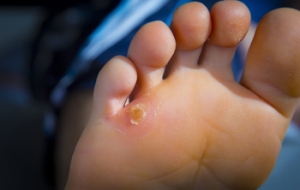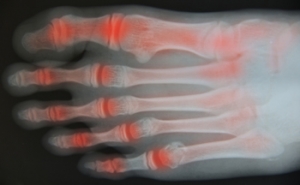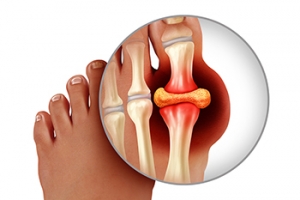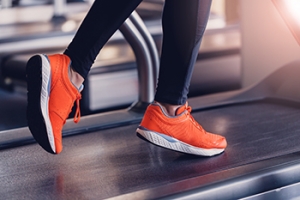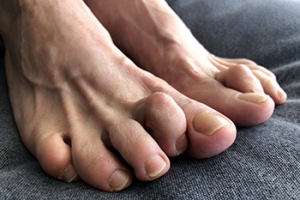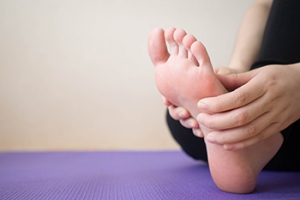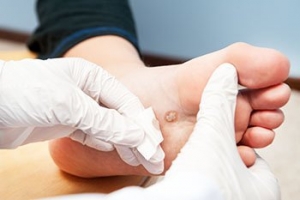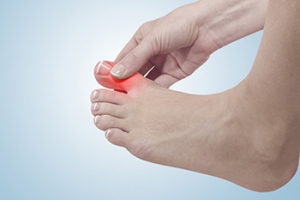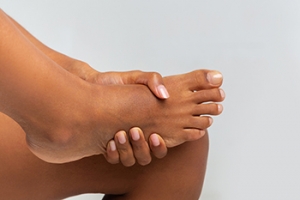Super User
Treatment for Corns on the Feet

Corns on the feet can be a painful and frustrating problem. These small, hardened areas of skin can develop on the toes or bottom of the feet from friction or pressure. One cause of corns is wearing tight or improperly-fitted shoes, which can create constant friction on specific areas of the feet, leading to the formation of these painful skin growths. Also, individuals with foot deformities, such as bunions or hammertoes, may be more susceptible to developing corns. Frequent wearing of high heels, which shifts body weight toward the front of the foot and increases pressure on the toes, often results in corn development. Athletes or those engaged in activities that repeatedly stress the feet are also at a higher risk. Treatment of corns includes wearing comfortable, well-fitted shoes, using cushioned pads to alleviate pressure, and considering custom-made orthotic insoles to correct foot alignment. If a corn persists and causes discomfort, it is suggested that you make an appointment with a podiatrist. This foot doctor can safely remove a problematic corn and evaluate your feet to determine if custom orthotics may be needed in the future.
If you have any concerns regarding your feet and ankles, contact Dr. John Branwell of Kearny, New Jersey. Our doctor will treat your foot and ankle needs.
Corns: What Are They? and How Do You Get Rid of Them?
Corns can be described as areas of the skin that have thickened to the point of becoming painful or irritating. They are often layers and layers of the skin that have become dry and rough, and are normally smaller than calluses.
Ways to Prevent Corns
There are many ways to get rid of painful corns such as wearing:
- Well-fitting socks
- Comfortable shoes that are not tight around your foot
- Shoes that offer support
Treating Corns
Treatment of corns involves removing the dead skin that has built up in the specific area of the foot. Consult with Our doctor to determine the best treatment option for your case of corns.
If you have any questions please feel free to contact our office located in Kearny, NJ . We offer the newest diagnostic and treatment technologies for all your foot and ankle needs.
Understanding Corns and Calluses
Corns and Calluses are both hardened layers of thickened skin that develop because of friction. Both ailments are typically found on the feet and may be unsightly. Although they have similarities, corns and calluses are different from each other.
Some causes of corns and calluses may be wearing ill-fitting shoes and not wearing socks. If you wear tight shoes, your feet will constantly be forced to rub against the shoes, causing friction. If you fail to wear socks, you are also causing your feet to endure excess friction.
There are some signs that may help you determine whether you have one of these two conditions. The first symptom is a thick, rough area of skin. Another common symptom is a hardened, raised bump on the foot. You may also experience tenderness or pain under the skin in addition to flaky, dry, or waxy skin.
There are also risk factors that may make someone more prone to developing corns and calluses. If you are already dealing with bunions or hammertoe, you may be more vulnerable to having corns and calluses as well. Other risk factors are foot deformities such as bone spurs, which can cause constant rubbing inside the shoe.
Corns tend to be smaller than calluses and they usually have a hard center surrounded by inflamed skin. They also tend to develop on the parts of the body that don’t bear as much weight such as the tops and sides of toes. Corns may also be painful for those who have them. On the other hand, calluses are rarely painful. These tend to develop on the bottom of the feet and may vary in size and shape.
Fortunately, most people only need treatment for corns and calluses if they are experiencing discomfort. At home treatments for corns and calluses should be avoided, because they will likely lead to infection. If you have either of these ailments it is advised that you consult with your podiatrist to determine the best treatment option for you.
Assistive Devices for Foot or Ankle Arthritis
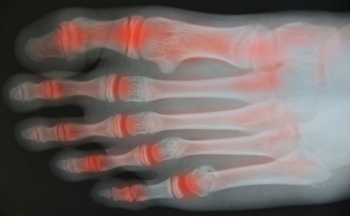
Assistive devices can be invaluable allies in the daily life of someone living with foot or ankle arthritis. These tools reduce joint stress, making activities more enjoyable and less tiring. For example, grab bars and bath seats can enhance safety and stability in the bathroom. Walking aids like canes should be used properly at the correct height. Podiatrists can recommend suitable assistive devices tailored to specific arthritis needs, helping maintain independence and complete daily activities. These devices are increasingly user-friendly and mainstream, making them accessible to all. If you have foot or ankle arthritis and would like to know more about devices that can make living your life easier, it is suggested that you make an appointment with a podiatrist who is well-versed in this area.
Arthritis can be a difficult condition to live with. If you are seeking treatment, contact Dr. John Branwell from Kearny, New Jersey. Our doctor can provide the care you need to keep you pain-free and on your feet.
Arthritic Foot Care
Arthritis is a term that is commonly used to describe joint pain. The condition itself can occur to anyone of any age, race, or gender, and there are over 100 types of it. Nevertheless, arthritis is more commonly found in women compared to men, and it is also more prevalent in those who are overweight. The causes of arthritis vary depending on which type of arthritis you have. Osteoarthritis for example, is often caused by injury, while rheumatoid arthritis is caused by a misdirected immune system.
Symptoms
- Swelling
- Pain
- Stiffness
- Decreased Range of Motion
Arthritic symptoms range in severity, and they may come and go. Some symptoms stay the same for several years but could potentially get worse with time. Severe cases of arthritis can prevent its sufferers from performing daily activities and make walking difficult.
Risk Factors
- Occupation – Occupations requiring repetitive knee movements have been linked to osteoarthritis
- Obesity – Excess weight can contribute to osteoarthritis development
- Infection – Microbial agents can infect the joints and trigger arthritis
- Joint Injuries – Damage to joints may lead to osteoarthritis
- Age – Risk increases with age
- Gender –Most types are more common in women
- Genetics – Arthritis can be hereditary
If you suspect your arthritis is affecting your feet, it is crucial that you see a podiatrist immediately. Your doctor will be able to address your specific case and help you decide which treatment method is best for you.
If you have any questions, please feel free to contact our office located in Kearny, NJ . We offer the newest diagnostic and treatment technologies for all your foot care needs.
Definition, Causes, and Avenues of Treatment for Gout
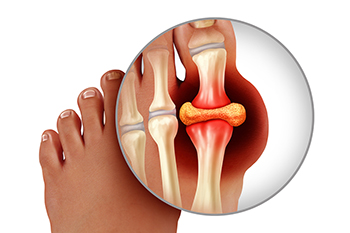
Gout, a complex form of arthritis, is often accompanied by intense pain and inflammation that targets the joints, including the feet. This condition results from the accumulation of uric acid crystals in the joints, leading to sudden and excruciating attacks of pain. The underlying cause is often an overproduction or inefficient excretion of uric acid, which is a waste product. Dietary factors, such as high purine foods and excessive alcohol consumption, can exacerbate gout. Managing gout involves implementing various treatment methods. Medications may help to reduce pain and inflammation during attacks, while long term strategies focus on lowering uric acid levels. This can be accomplished through lifestyle adjustments and prescribed medications. Consulting a podiatrist is paramount in tailoring an effective treatment plan. If you are afflicted with gout, it is strongly suggested that you are under the care of this type of doctor who can effectively help you to manage this condition.
Gout is a painful condition that can be treated. If you are seeking treatment, contact Dr. John Branwell from Kearny, New Jersey. Our doctor will treat your foot and ankle needs.
What Is Gout?
Gout is a form of arthritis that is characterized by sudden, severe attacks of pain, redness, and tenderness in the joints. The condition usually affects the joint at the base of the big toe. A gout attack can occur at any random time, such as the middle of the night while you are asleep.
Symptoms
- Intense Joint Pain - Usually around the large joint of your big toe, and it most severe within the first four to twelve hours
- Lingering Discomfort - Joint discomfort may last from a few days to a few weeks
- Inflammation and Redness -Affected joints may become swollen, tender, warm and red
- Limited Range of Motion - May experience a decrease in joint mobility
Risk Factors
- Genetics - If family members have gout, you’re more likely to have it
- Medications - Diuretic medications can raise uric acid levels
- Gender/Age - Gout is more common in men until the age of 60. It is believed that estrogen protects women until that point
- Diet - Eating red meat and shellfish increases your risk
- Alcohol - Having more than two alcoholic drinks per day increases your risk
- Obesity - Obese people are at a higher risk for gout
Prior to visiting your podiatrist to receive treatment for gout, there are a few things you should do beforehand. If you have gout you should write down your symptoms--including when they started and how often you experience them, important medical information you may have, and any questions you may have. Writing down these three things will help your podiatrist in assessing your specific situation so that he or she may provide the best route of treatment for you.
If you have any questions, please feel free to contact our office located in Kearny, NJ . We offer the newest diagnostic and treatment technologies for all your foot care needs.
Stretching for Runners
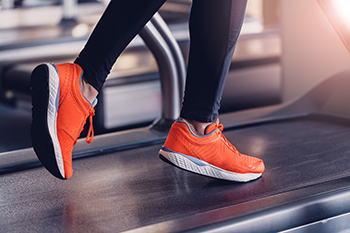
Running can be an exhilarating way for individuals to exercise. However, it can also put significant strain on the feet. If the feet are not properly cared for and stretched, running may put the feet at increased risk of injury. Runners might stand to benefit from performing certain specific foot stretches. For instance, if you are a runner, you might consider performing lacrosse ball plantar surface rolling. This may be done from a seated position where you place a ball underneath the foot and gently roll the ball forward and backward across your plantar fascia. This can be performed for one minute on each foot. By performing this stretch, a runner can effectively stretch their plantar fascia and prepare it for more running. If you are a runner and are looking to prevent injury, it is recommended that you schedule an appointment with a podiatrist.
Stretching the feet is a great way to prevent injuries. If you have any concerns with your feet consult with Dr. John Branwell from Kearny, New Jersey. Our doctor will assess your condition and provide you with quality foot and ankle treatment.
Stretching the Feet
Being the backbone of the body, the feet carry your entire weight and can easily become overexerted, causing cramps and pain. As with any body part, stretching your feet can serve many benefits. From increasing flexibility to even providing some pain relief, be sure to give your feet a stretch from time to time. This is especially important for athletes or anyone performing aerobic exercises, but anyone experiencing foot pain or is on their feet constantly should also engage in this practice.
Great ways to stretch your feet:
- Crossing one leg over the others and carefully pull your toes back. Do 10-20 repetitions and repeat the process for each foot
- Face a wall with your arms out and hands flat against the wall. Step back with one foot and keep it flat on the floor while moving the other leg forward. Lean towards the wall until you feel a stretch. Hold for 30 seconds and perform 10 repetitions for each foot
- Be sure not to overextend or push your limbs too hard or you could risk pulling or straining your muscle
Individuals who tend to their feet by regular stretching every day should be able to minimize foot pain and prevent new problems from arising.
If you have any questions, please feel free to contact our office located in Kearny, NJ . We offer the newest diagnostic and treatment technologies for all your foot care needs.
Effective Stretches for Hammertoe

People who have the foot condition that is known as hammertoe will notice their toes are rigid. Hammertoe can happen from genetic reasons or from wearing shoes that do not have ample room in the toe area. This can cause the toes to shift together, and the pressure can make the second and third toes bend downward at the middle joint. It is sometimes painful while wearing shoes, and corns and calluses may form on the bent joint as it touches the top of the shoe. Stretches can be performed which may help to increase the toe's flexibility. A toe crunch is done while sitting in a chair, and placing a towel under your feet. The toes can be stretched by gripping the towel continually as you make your way to the end of it. An effective stretch can be done with a towel, as it is wrapped around the toes and pulled gently toward you. After holding for several seconds, this can be repeated. If you have developed hammertoe, it is suggested that you consult with a podiatrist who can help you to manage this condition.
Hammertoe
Hammertoes can be a painful condition to live with. For more information, contact Dr. John Branwell from Kearny, New Jersey. Our doctor will answer any of your foot- and ankle-related questions.
Hammertoe is a foot deformity that affects the joints of the second, third, fourth, or fifth toes of your feet. It is a painful foot condition in which these toes curl and arch up, which can often lead to pain when wearing footwear.
Symptoms
- Pain in the affected toes
- Development of corns or calluses due to friction
- Inflammation
- Redness
- Contracture of the toes
Causes
Genetics – People who are genetically predisposed to hammertoe are often more susceptible
Arthritis – Because arthritis affects the joints in your toes, further deformities stemming from arthritis can occur
Trauma – Direct trauma to the toes could potentially lead to hammertoe
Ill-fitting shoes – Undue pressure on the front of the toes from ill-fitting shoes can potentially lead to the development of hammertoe
Treatment
Orthotics – Custom made inserts can be used to help relieve pressure placed on the toes and therefore relieve some of the pain associated with it
Medications – Oral medications such as anti-inflammatories or NSAIDs could be used to treat the pain and inflammation hammertoes causes. Injections of corticosteroids are also sometimes used
Surgery – In more severe cases where the hammertoes have become more rigid, foot surgery is a potential option
If you have any questions please contact our office located in Kearny, NJ . We offer the newest diagnostic and treatment technologies for all your foot and ankle needs.
Causes of Pain on the Outer Part of the Foot

Pain on the outer edge of the foot can be debilitating, affecting how you walk or even stand. It can cause instability and keep you from participating in your everyday activities. This type of injury, termed lateral foot pain, can result in stabbing, burning pain, or severe aching. A number of conditions, including ankle sprains, arthritis, or a bunionette can cause lateral foot pain. Ankle sprains, particularly in people with high arches, are thought to be the most common cause of lateral foot pain. In addition, a fifth metatarsal fracture, which connects the pinky toe to the ankle, commonly accompanies an ankle sprain and contributes to the pain. Various forms of arthritis can produce inflammation in any one of the many joints in the feet. A bunion on the small toe is a bone deformity and is often termed a bunionette. Pain is caused when the protruding bone rubs against the inside of the shoe. Among the other causes of lateral foot pain include a dislocation of the cuboid bone, which is located at the outside part of the foot. This injury is common among ballet dancers and other athletes. To find out exactly what is causing the pain on the outside of your foot, it is suggested that you consult a podiatrist.
Foot Pain
Foot pain can be extremely painful and debilitating. If you have a foot pain, consult with Dr. John Branwell from Kearny, New Jersey. Our doctor will assess your condition and provide you with quality foot and ankle treatment.
Causes
Foot pain is a very broad condition that could be caused by one or more ailments. The most common include:
- Bunions
- Hammertoes
- Plantar Fasciitis
- Bone Spurs
- Corns
- Tarsal Tunnel Syndrome
- Ingrown Toenails
- Arthritis (such as Gout, Rheumatoid, and Osteoarthritis)
- Flat Feet
- Injury (from stress fractures, broken toe, foot, ankle, Achilles tendon ruptures, and sprains)
- And more
Diagnosis
To figure out the cause of foot pain, podiatrists utilize several different methods. This can range from simple visual inspections and sensation tests to X-rays and MRI scans. Prior medical history, family medical history, and any recent physical traumatic events will all be taken into consideration for a proper diagnosis.
Treatment
Treatment depends upon the cause of the foot pain. Whether it is resting, staying off the foot, or having surgery; podiatrists have a number of treatment options available for foot pain.
If you have any questions, please feel free to contact our office located in Kearny, NJ . We offer the newest diagnostic and treatment technologies for all your foot care needs.
Where Is a Plantar Wart Found?

Plantar warts can cause a considerable amount of pain and discomfort. They occur when the human papillomavirus, which is abbreviated as HPV, enters the body through small cracks in the skin on the feet. They are found on the soles of the feet and grow inward as a result of the weight the feet endure while walking and running, possibly causing severe pain. A plantar wart is a small bump with a rough consistency, and it often has small black dots in the center. Certain people may be prone to getting a plantar wart, including people who have a weakened immune system, or it may come from sharing shoes, towels, and socks. There are various treatment methods that can be used on plantar warts, and it is suggested that you confer with a podiatrist who can determine what the best course of treatment is for you.
Plantar warts can be very uncomfortable. If you need your feet checked, contact Dr. John Branwell from Kearny, New Jersey. Our doctor will assist you with all of your foot and ankle needs.
About Plantar Warts
Plantar warts are the result of HPV, or human papillomavirus, getting into open wounds on the feet. They are mostly found on the heels or balls of the feet.
While plantar warts are generally harmless, those experiencing excessive pain or those suffering from diabetes or a compromised immune system require immediate medical care. Plantar warts are easily diagnosed, usually through scraping off a bit of rough skin or by getting a biopsy.
Symptoms
- Lesions on the bottom of your feet, usually rough and grainy
- Hard or thick callused spots
- Wart seeds, which are small clotted blood vessels that look like little black spots
- Pain, discomfort, or tenderness of your feet when walking or standing
Treatment
- Freezing
- Electric tool removal
- Laser Treatment
- Topical Creams (prescription only)
- Over-the-counter medications
To help prevent developing plantar warts, avoid walking barefoot over abrasive surfaces that can cause cuts or wounds for HPV to get into. Avoiding direct contact with other warts, as well as not picking or rubbing existing warts, can help prevent the further spread of plantar warts. However, if you think you have developed plantar warts, speak to your podiatrist. He or she can diagnose the warts on your feet and recommend the appropriate treatment options.
If you have any questions please feel free to contact our office located in Kearny, NJ . We offer the newest diagnostic and treatment technologies for all your foot and ankle needs.
Surgery for Big Toe Arthritis

Arthritis often strikes the joint connecting the big toe to the ball of the foot and can cause significant pain. This affliction is more common as one ages and cartilage wears away between the bones. A surgery can be performed where the bones are fused together with metal plates, but this can limit the flexibility of the toe. Another option is a type of implant that can be inserted between the bones and can cushion the aching joint. Such an implant can be as small as a miniature marshmallow. It is made of saline solution and polyvinyl alcohol, like that used in soft contact lenses. This material compresses a bit under pressure, much like real cartilage. If you suffer from arthritis in the big toe, consult with a podiatrist to see if surgery is a treatment that is right for you.
Foot surgery is sometimes necessary to treat a foot ailment. To learn more, contact Dr. John Branwell of Kearny, New Jersey. Our doctor will assist you with all of your foot and ankle needs.
When Is Surgery Necessary?
Foot and ankle surgery is generally reserved for cases in which less invasive, conservative procedures have failed to alleviate the problem. Some of the cases in which surgery may be necessary include:
- Removing foot deformities like bunions and bone spurs
- Severe arthritis that has caused bone issues
- Cosmetic reconstruction
What Types of Surgery Are There?
The type of surgery you receive will depend on the nature of the problem you have. Some of the possible surgeries include:
- Bunionectomy for painful bunions
- Surgical fusion for realignment of bones
- Neuropathy decompression surgery to treat nerve damage
Benefits of Surgery
Although surgery is usually a last resort, it can provide more complete pain relief compared to non-surgical methods and may allow you to finally resume full activity.
Surgical techniques have also become increasingly sophisticated. Techniques like endoscopic surgery allow for smaller incisions and faster recovery times.
If you have any questions please feel free to contact our office located in Kearny, NJ . We offer the newest diagnostic and treatment technologies for all your foot and ankle needs.
Foot Pain and the Effect on the Body

There are many reasons why any individual ought to take the health of their feet seriously. One of the most important reasons is because pain in the feet can often have consequential, secondary effects on the body. For example, when an individual is experiencing foot pain, they will often exhibit the effects of this pain by choosing to sit for longer periods of time throughout the day. Also, when an individual has foot pain, this will sometimes affect the way in which a person walks, altering their gait. This is so because foot pain can make an individual alter how they put weight on their feet, avoiding certain particularly vulnerable parts of the feet. However, this, of course, is not the way that it has to be. By consulting a podiatrist, an individual will be able to treat foot pain so that it does not affect how they walk. Consult a podiatrist today to make sure that you are doing all you can to take care of your feet.
Everyday foot care is very important to prevent infection and other foot ailments. If you need your feet checked, contact Dr. John Branwell from Kearny, New Jersey. Our doctor can provide the care you need to keep you pain-free and on your feet.
Everyday Foot Care
Often, people take care of their bodies, face and hair more so than they do for their feet. But the feet are a very important aspect of our bodies, and one that we should pay more attention to. Without our feet, we would not be able to perform most daily tasks.
It is best to check your feet regularly to make sure there are no new bruises or cuts that you may not have noticed before. For dry feet, moisturizer can easily be a remedy and can be applied as often as necessary to the affected areas. Wearing shoes that fit well can also help you maintain good foot health, as well as making it easier to walk and do daily activities without the stress or pain of ill-fitting shoes, high heels, or even flip flops. Wearing clean socks with closed shoes is important to ensure that sweat and bacteria do not accumulate within the shoe. Clean socks help to prevent Athlete’s foot, fungi problems, bad odors, and can absorb sweat.
If you have any questions please feel free to contact our office located in Kearny, NJ . We offer the newest diagnostic and treatment technologies for all your foot and ankle needs.
